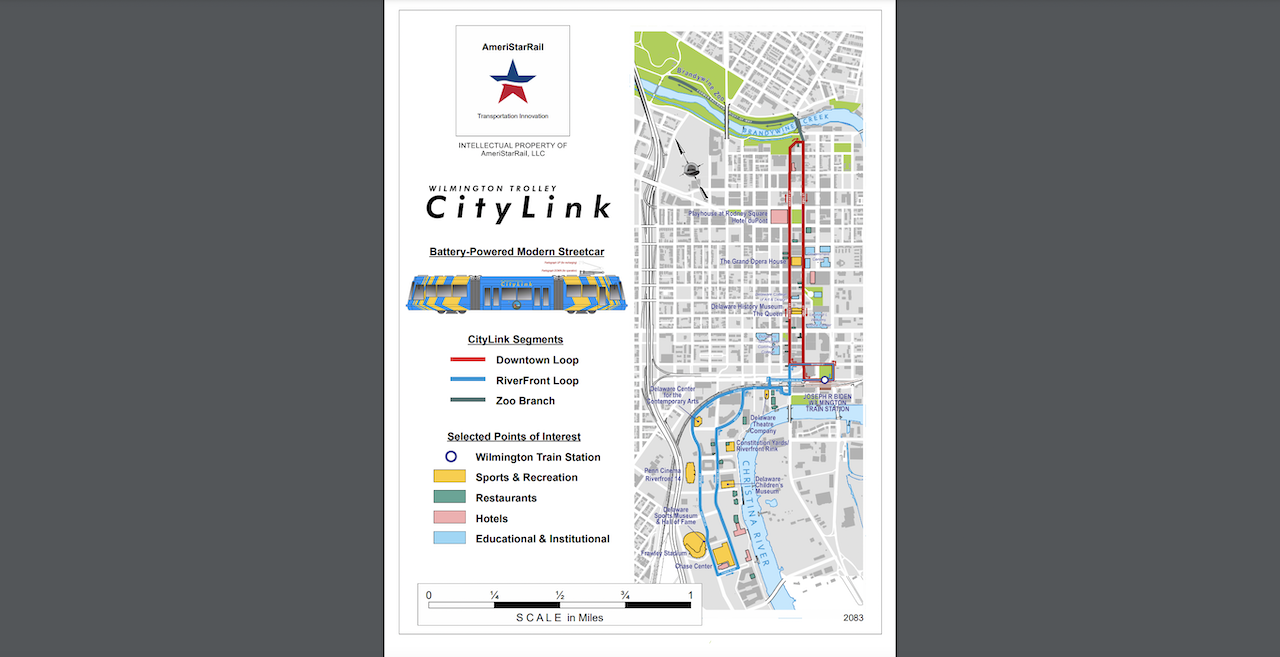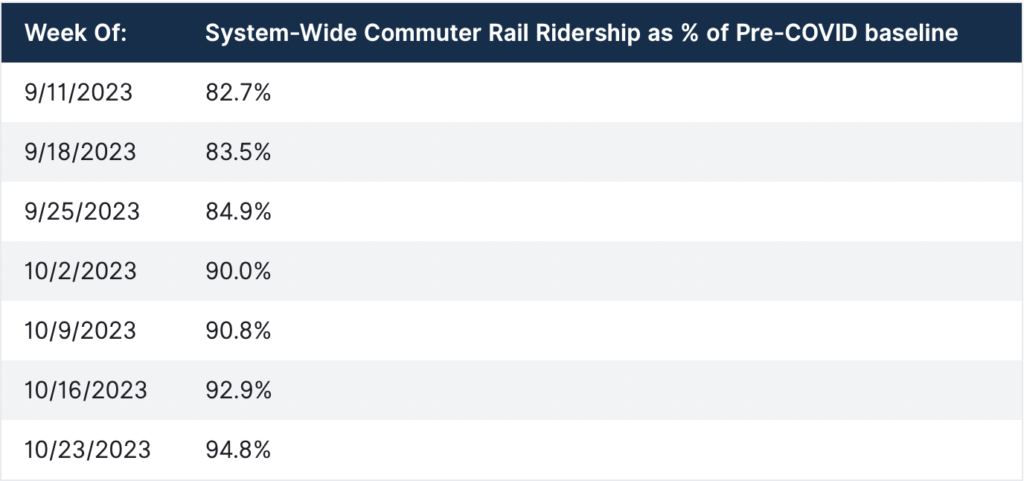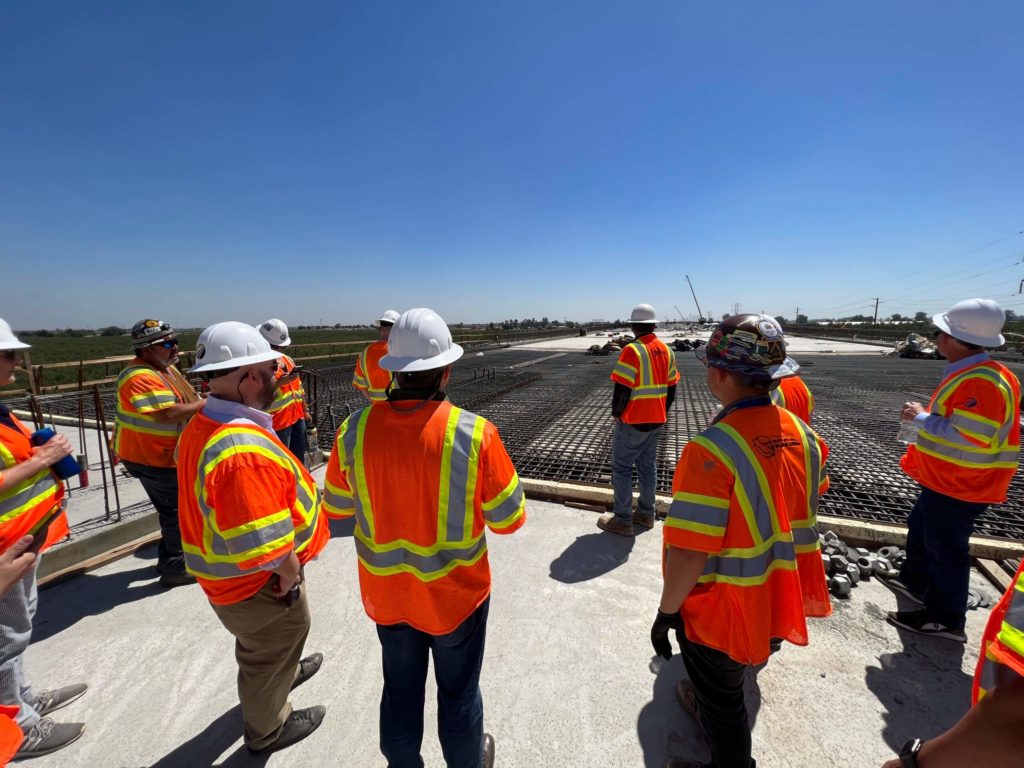
Transit Briefs: AmeriStarRail, CTA, MBTA, Gateway Development Commission, MDOT, SEPTA, CHSRA
Written by Carolina Worrell, Senior Editor
AmeriStarRail is proposing a battery electric streetcar system for Wilmington, Del.
AmeriStarRail proposes a battery electric streetcar system for Wilmington, Del. Also, CTA President Dorval R. Carter is named Equity in Infrastructure Project (EIP) Co-Chair; the Massachusetts Bay Transportation Authority (MBTA) aims to boost officer retention with a new Police Association contract and announces that Commuter Rail ridership has reached a new post-pandemic peak; the Gateway Development Commission can now officially receive checks from the Federal Transit Administration (FTA); the Maryland Department of Transportation (MDOT) awards two contracts to study potential transit-oriented development (TOD) at light rail and subway stations; the Southeastern Pennsylvania Transportation Authority (SEPTA) Board approves a new contract agreement with TWU Local 234; and the California High-Speed Rail Authority (CHSRA) enters into an agreement with 13 rail labor unions.
AmeriStarRail
During a Nov. 14 public hearing for the Delaware Department of Transportation (DelDOT) FY2025 budget before Governor John Carney’s Office of Management and Budget (OMB), Scott Spencer, Chief Officer for AmeriStarRail proposed that the Governor and DelDOT consider developing a streetcar system for the state’s largest city—Wilmington.
AmeriStarRail is proposing that the streetcar system operate with battery electric trolleys to eliminate the need to build overhead power lines above city streets except at the recharging terminal. AmeriStarRail also proposed that the Wilmington Trolley CityLink be operated fare-free with a combination of DelDOT subsidies and corporate sponsorship to encourage “easy-on, easy-off” ridership.
“Wilmington is the largest city between New York and Washington without a rail transit link to its Amtrak train station,” said Spencer. “AmeriStarRail is proposing the Wilmington Trolley CityLink to provide a car-free, zero emissions, rail transit link connecting Downtown Wilmington offices, residences, hotels, theaters, shops and restaurants with the attractions and residences on the Riverfront via the Amtrak/SEPTA train station.”
According to AmeriStarRail, specs of the proposed Wilmington Streetcar CityLink include the following:
- “Battery electric trolleys operate every 10 minutes, 7 days-a-week.
- “Approximately 2 route miles long.
- “Connections to Amtrak, SEPTA and DART routes.
- “Provides a fast, frequent way to connect the city across Martin Luther King Jr. Blvd.
- “Weekday park and ride lots for commuters on the Riverfront reduces Downtown Wilmington traffic and parking congestion.
- “Fare Free trolleys provides fast, frequent transit service to encourage “easy on, easy off” use of transit between restaurants, theaters, shops and other attractions.
- “Rotating corporate sponsorships and government operating subsidies will provide Fare Free service to attract new businesses, residents and more visitors to Wilmington.
- “Each trolley has capacity for 100+ passengers and is ADA and bike accessible.”
“Fast, frequent, fare-free trolley transit service will generate economic growth by attracting more businesses, residents and visitors to Wilmington,” Spencer added.
More information about the Wilmington Trolley CityLink is available here.
CTA
EIP, a national group focused on improving and creating contracting opportunities for Historically Underutilized Businesses (HUBs), has chosen CTA President Dorval R. Carter, Jr. as its Co-Chair, the agency announced on Nov. 16.
According to CTA, Carter was one the original five signatories of the EIP pledge, “a commitment to helping build generational wealth and reduce the racial wealth gap by assisting HUBs that seek to participate in large infrastructure projects as prime contractors, joint venture partners or as equity participants.”
“As someone for whom equity has been a foundational principle, my involvement with EIP has been important both personally and professionally,” said Carter. “Since EIP launched two years ago, CTA has been fully committed to moving it forward, in part by sharing the successful local initiatives executed by CTA’s Diversity Programs Department with our transit peers, and creating national models that can be replicated, by transit and transportation entities, as well cities across the country.”
EIP—which has emerged as a national leader in the infrastructure space—was founded prior to the $1.2 trillion Infrastructure Investment and Jobs Act (IIJA), with a mission to leverage infrastructure spending to build wealth in underserved communities. CTA joined the Denver International Airport, the Port of Long Beach, the Metropolitan Water District of Southern California, and SEPTA as the first members of EIP, helping create the program’s first effort: the EIP Pledge. Entities signing the pledge have committed to using funds from the IIJA to increase contracting opportunities going to HUBs by facilitating access and reducing barriers to compete for business.
As part of the EIP program, earlier this year, CTA and SEPTA signed a memorandum of understanding (MOU) committing to the development of a first-of-its-kind interstate certification program for Small Business Enterprise (SBE) firms. The program will allow SBEs to compete as potential prime contractors for small business set-aside contracts with both CTA and SEPTA following a single certification—an opportunity that currently does not exist. The program will provide a model that other public transportation agencies will be able to adopt, opening new markets and contracting possibilities for participating SBEs.
EIP’s definition of “HUBs” includes Disadvantaged Business Enterprises (DBEs), Minority and Women-Owned Business Enterprises (M/WBEs), SBEs and any other business classification used locally in the U.S. “that is intended to boost the participation of otherwise underutilized firms, which can vary by state, region, and municipality.”
MBTA
The MBTA Board of Directors on Nov. 16 unanimously approved a new four-year contract between the MBTA and the Police Association, which the agency says will “endeavor to improve retention and support frontline patrol officers within the MBTA Transit Police Department through expanded benefits and increased wages.”
In a joint address to the MBTA Board of Directors, General Manager Phillip Eng and Transit Police Chief Kenneth Green updated the board on the positive impacts they foresee this contract having on the workforce as Green approaches his 33rd year of service to the MBTA.
“We are steadfast in our commitment to rebuilding our workforce, including our Transit Police Officers responsible for protecting the public and our workers,” said Eng. “This contract and the speed at which we reached an agreement convey our understanding of the difficult but vital role our brave officers perform, putting the safety of our riders first every day. We’re grateful to have Chief Kenneth Green at the helm and appreciate his remarkable contributions to the MBTA over the past 33 years. His leadership and expertise continue to play a pivotal role in our ability to offer reliable service to the communities we serve.”
The four-year contract, beginning July 1, 2023, and lasting through June 30, 2027, includes:
- Overall wage increases. Approximately 18% wage adjustment over four years, averaging approximately 4.5% per year.
- Retirement Eligible Retention bonuses.
- Implementing a Longevity Bonus program at 10, 15, 20, and 25 years to address current staffing shortages and retain frontline officers.
- A one-time bonus of 10% for eligible retirees to defer retirement to the end of 2024.
The deal also expands the definition of bereavement leave to include domestic partners.
Separately, MBTA and Keolis Commuter Services on Nov. 17 announced that Commuter Rail ridership reached a new post-pandemic peak in October bolstered by Halloween travel to Salem and Fairmount Line ridership during the Ashmont-Mattapan closure.
According to MBTA, for four weeks, the average weekly ridership of the Commuter Rail systemwide exceeded 90% of pre-COVID levels. While ridership across the Commuter Rail network was high in October, three lines in particular saw significant jumps compared to their September averages: the Newburyport/Rockport, Fairmount, and Franklin lines.
The Franklin Line saw a ridership increase in October of nearly 20% compared to September, which, MBTA says is attributed to the new Fall/Winter schedule service increases on that line. The Fairmount Line saw a nearly 35% increase in ridership during the Red Line Ashmont Branch and Mattapan Line construction. The Newburyport/ Rockport Line saw record ridership as crowds rode the train to Salem for the Haunted Happenings festivities.


During the height of the pandemic, Commuter Rail ridership dropped down to approximately 10% of pre-COVID levels. In the 2021 Spring/Summer Schedule, Keolis and the MBTA introduced a new all-day service model providing service at regular intervals throughout the day and increasing service on the weekends. This new service model has corresponded with a steady increase in ridership.
“Seeing ridership on Commuter Rail return and grow consistently to reach this milestone demonstrates that safe, reliable, and more frequent service can bring riders back to mass transportation,” said Eng. “Thank you to our partners at Keolis for providing more frequent and convenient train service, making it easier and more attractive to the public to choose this option. We look forward to continuing to build upon this success to identify new ways to improve service, get more people out of cars, and protect our environment by reducing our carbon footprint.”
Gateway Development Commission
The Gateway Development Commission can now officially receive checks from the FTA for the new rail tunnel project that will connect New Jersey and Manhattan under the Hudson River, Kris Kolluri, who heads the Commission announced at a recent board meeting, according to a northjersey.com report.
According to the report, the FTA completed its review of the Gateway package and determined that the Commission “meets federal requirements to receive funding,” said a Nov.15 letter from FTA acting Regional Administrator Michael Culotta.
The letter, northjersey.com reports, “signifies that the FTA believes the Gateway Development Commission—a bistate agency formed two years ago to receive federal funds for the $16.1 billion Hudson tunnels project and to oversee the project—has the legal and technical experience to manage the complexities of the largest federally funded capital program in the country.”
Accrording to the report, the letter also lays the groundwork for the agency to reach a full funding grant agreement, expected in June, which is “necessary in order to begin receiving the estimated $6.88 billion in funds expected through the Capital Investments Grant program.”
The Gateway Development Commission was also awarded a separate grant of $3.9 billion, through the Federal Railroad Administration’s (FRA) Federal-State Partnership for Intercity Passenger Rail Grant Program, announced earlier this month.
“That grant and the Capital Investments Grant will bring the federal contribution to roughly $11 billion,” according to the report. “That plus Amtrak’s share will cover around 70% of the total project costs, leaving New Jersey and New York to split the rest, a significantly lower amount than previously expected.”
The $18.4 billion first phase of the Gateway Program will include essential repairs on the Northeast Corridor (NEC) and has three major components.
A new two-track rail tunnel will be built under the Hudson River between North Jersey and Manhattan, going into New York Penn Station, “making rail service more reliable for the hundreds of thousands who travel from New Jersey to Manhattan,” according to the northjersey.com report.
According to the report, once the new tunnel is finished, “the antiquated North River Tunnel beneath the Hudson will be shut down and repaired while train traffic shifts to the new tunnel.” The old tunnel, which opened in 1910 and is used by Amtrak and NJ Transit, was severely damaged during Superstorm Sandy in 2012. It has two tracks in and one out, with little flexibility if an incident occurs in the tunnel.
The Portal Bridge, the same age as the old tunnels and a “critical chokepoint on the Northeast Corridor near Kearny,” is also being rebuilt for an estimated $2.3 billion, a project being led by NJ Transit, according to the report.
MDOT
MDOT on Nov. 16 announced that two contracts have been awarded to study potential TOD sites at light rail and subway stations in the Baltimore region and at MARC Penn Line stations in the Baltimore-Washington corridor.
According to MDOT, the contracts were awarded by the department’s partner, Maryland Economic Development Corporation, and are “an important step in the state’s commitment to a bold new approach to create vibrant, diverse transit hubs and advance Governor Wes Moore’s vision of transit as a catalyst to lift neighborhoods, boost the economy and connect residents to opportunity.”
The two study contracts were awarded in recent weeks to the international research and consulting firm HR&A Advisors Inc., which has served as a consultant and master plan developer for projects in New York City; Washington D.C.; Los Angeles; Research Triangle, N.C.; Houston, Texas; and dozens of other communities in the U.S. and abroad.
The Baltimore Region Study will examine the Maryland Transit Administration’s (MTA) Light Rail and Metro Subway stations in the Baltimore region to identify sites with strong market potential for TOD that can provide new transit access and economic opportunity for communities. The study will evaluate the overall market for transit-oriented in the Baltimore region, identify challenges, opportunities and tools needed to incentivize impactful transit-oriented development; and engage with communities and potential private, institutional and nonprofit partners.
The Penn Line Study will initially look at MARC stations along the Baltimore-Washington corridor—Seabrook, Bowie State, Odenton, Baltimore/Washington International Thurgood Marshall Airport, Halethorpe and West Baltimore—and examine market potential, infrastructure, investment needs, benefits and financing. A second phase will study stations north of Baltimore, including Martin State Airport, Edgewood, Aberdeen and Perryville. Both phases will consider the impact of MARC service expansion. Cross-state service into Delaware and Virginia is anticipated based on Maryland’s recent framework agreements with both states to advance discussions and explore pilot service opportunities.
The contract awards stem from two requests for proposals (RFP) announced in August by MDOT and the Maryland Economic Development Corporation. Both studies, MDOT says, will identify sites poised to become transit centers now, and determine needs at other sites that could be addressed to make them strong candidates in the future.
Both studies will be conducted in the coming months. “These efforts will analyze feasibility and overall goals for stations, which will then lead to master developer partnerships and a full community engagement process,” MDOT said.
SEPTA
The SEPTA Board on Nov. 17 approved the new contracts between SEPTA and TWU Local 234, covering employees in the City, Suburban and Frontier Transit Divisions.
Union members voted last week to ratify the one-year agreement, which includes a signing bonus, salary increases, and maintains health and pension benefits. It also includes changes to the wage progression rate that will allow SEPTA to offer higher starting salaries, which will bolster efforts to attract and retain new employees.
According to SEPTA, these contract agreements were reached “following around-the-clock negotiations last month, and there were no service disruptions to customers.” Negotiations, the agency says, were “focused on finding a way to recognize employees’ hard work and ensure that SEPTA is in the best possible position to build ridership as the recovery continues.”
“I want to thank the SEPTA negotiating team and TWU leadership for engaging in good-faith discussions and reaching this agreement that averted a service interruption for our customers,” said SEPTA Board Chairman Pasquale T. Deon Sr.
The contracts will expire in November 2024. TWU Local 234 represents about 5,000 transit-vehicle operators, mechanics, maintenance workers, cashiers, and custodians.
CHSRA
CHSRA on Nov. 17 announced that it has entered into an agreement with 13 rail labor unions, “ensuring the hard-earned gains in federal labor laws will be applicable to the operations of the nation’s first high-speed rail project.”
The 13 rail labor unions include:
- The Brotherhood of Maintenance of Way Employees Division (BMWED)
- Brotherhood of Railroad Signalmen (BRS)
- International Association of Sheet Metal, Air, Rail and Transportation Workers-Mechanical and Engineering Department (SMART-MD)
- National Conference of Firemen and Oilers 32BJ/SEIU (NCFO)
- Transportation Communications Union (TCU)
- International Association of Machinists and Aerospace Workers (IAM)
- Brotherhood of Railway Carmen (BRC)
- International Brotherhood of Boilermakers (IBB)
- Transport Workers Union of America (TWU)
- American Train Dispatchers Association (ATDA)
- International Association of Sheet Metal, Air, Rail and Transportation Workers-Transportation Department (SMART-TD)
- Brotherhood of Locomotive Engineers and Trainmen (BLET)
- International Brotherhood of Electrical Workers (IBEW)
This agreement, CHSRA says, will cover an estimated 3,000 workers who will operate and maintain high-speed trains, facilities, and stations from the Bay Area through the Central Valley and into Southern California. The running of the 171-mile Merced to Bakersfield Section alone will create nearly 400 operating jobs, a number that the Authority says will grow as the service expands beyond the Central Valley.

This agreement, CHSRA says, “ensures that the employees doing traditional rail work on the project will be able to determine for themselves what representation, if any, they want, and that those employees can be covered by the Rail Labor Act, the Railroad Retirement Act of 1974, and the Railroad Unemployment Insurance Act.” The agreement also ensures that basic labor provisions, including protecting employees from being questioned about their support or nonsupport for labor, and giving unions reasonable access to employees, will be enforced on the project.



